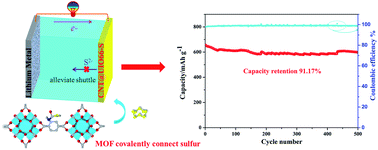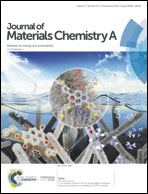A new cathode material synthesized by a thiol-modified metal–organic framework (MOF) covalently connecting sulfur for superior long-cycling stability in lithium–sulfur batteries†
Abstract
Although metal–organic frameworks (MOFs) are used to suppress the fast capacity fading of lithium–sulfur (Li–S) batteries, finding more effective ways to improve the long-cycling stability of lithium–sulfur batteries is still a huge challenge. In this work, an effective strategy to improve the cycle stability of lithium–sulfur batteries by covalently introducing sulfur in a metal–organic framework (MOF) was proposed for the first time; it is completely different from the traditional method of simply mixing MOFs with sulfur for designing sulfur cathodes. Compared with an Li–S cell using the simple blend of sulfur and MOFs as the cathode, the cell with the cathode consisting of sulfur covalently connected with the MOF showed outstanding long-cycling stability. Specifically, the lithium–sulfur battery with CNT@UIO66-S delivered high capacity retention of 80.19% even after 900 cycles at the current of 2C. Furthermore, at the current of 1C, the discharge capacity of the CNT@UIO66-S cell could still remain 608 mA h g−1 after 450 cycles, while it maintained 92.12% based on the first discharge capacity. It is believed that introducing sulfur in MOFs by covalent connection may open up a new promising method to further utilize MOFs in the field of Li–S batteries.



 Please wait while we load your content...
Please wait while we load your content...